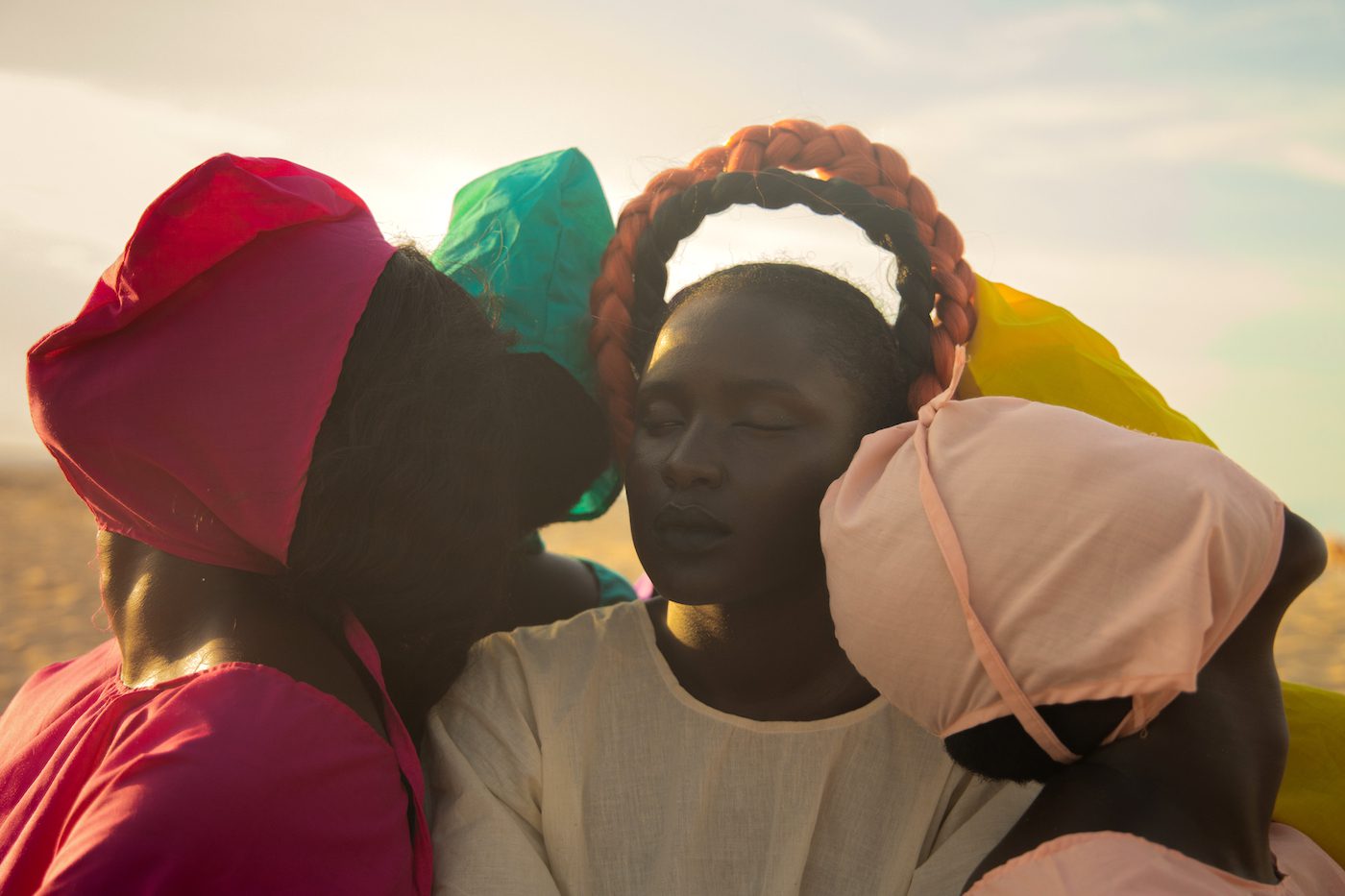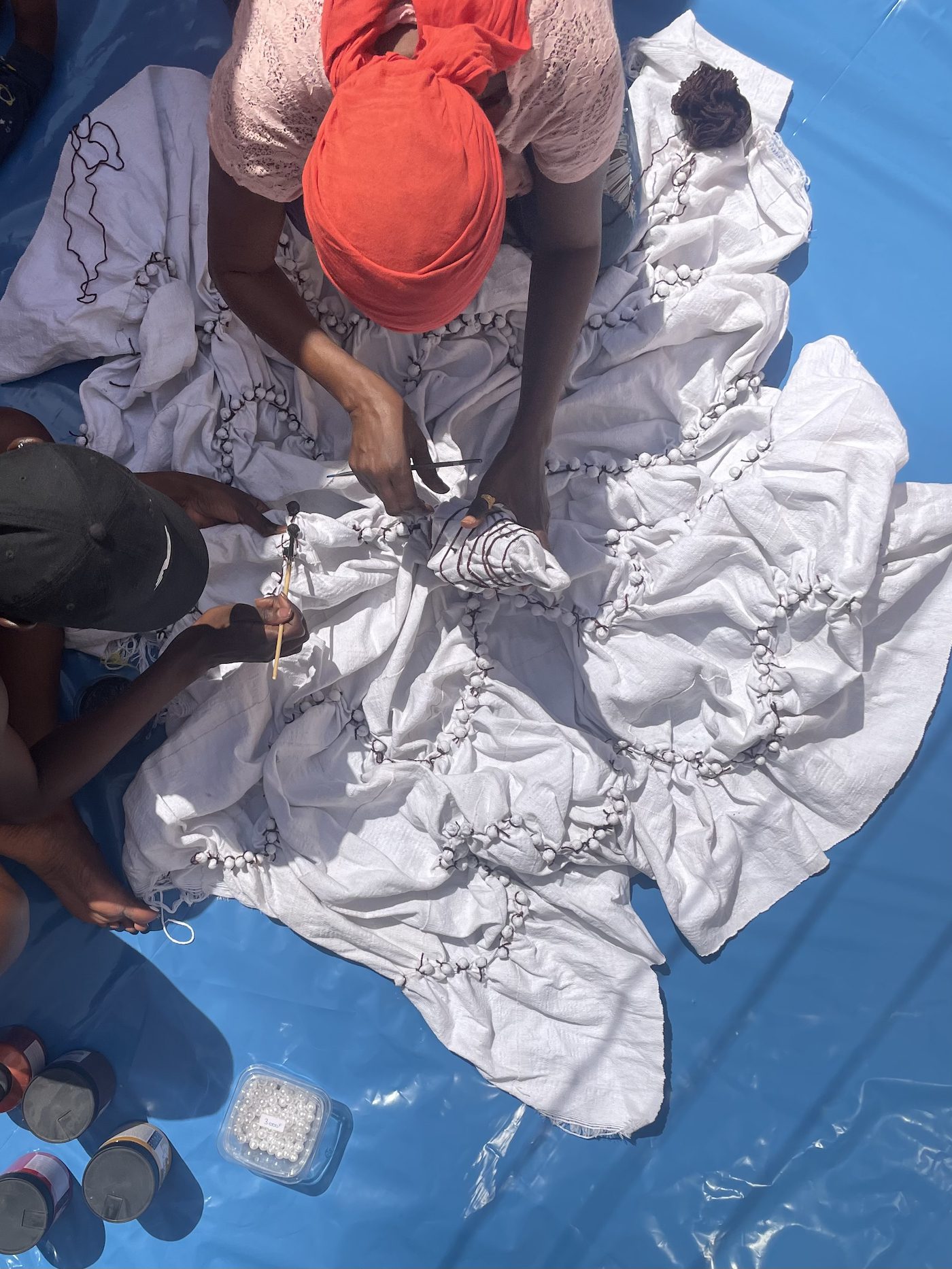They have worked together as a collective since 2019. And their shared practices highlight the various ways in which clothes can speak.

Atelier Ndokette, Ndokette Session, untitled, 2019. Courtesy of the artists.
Contemporary And: Could you tell us a bit about your beginnings and the development of your artistic practice as a collective?
Atelier Ndokette: We started to be active as a collective in 2019 when we worked on our first project together which combined our different personal skills and practices of art direction, design, staging and photography around clothing as a visual medium. In addition to archiving clothes, which we started earlier, we felt the responsibility to explore and exploit more. The archiving process is about selecting and combining garments. We treat garments as objects to be interrogated, informed by a material and a cultural framework.

Behind the scenes of Tocutugol, a solo exhibition by Atelier Ndokette, 2022. Courtesy of the artists.
We started by doing research around the Ndokette, a tunic worn by women that is distinguished by its sawing, materials and the way it is worn, by its variations and origins. Then we expanded our research to other garments that are familiar to all of us, very present in the clothing landscape and in the collective memory. These clothes represent a sort of « institution » in our community but at the same time they are casual. We are interested both in their institutional and institutionalising character.
We also wanted to develop and present our personal practices more widely. To be part of a collective has allowed us to give room to a certain form of multidisciplinarity. Over time, this practice has developed and become a space for research and exploration for the three of us.
C&: Is your primary interest to work with artisans and textiles?
AN: Artisans are our go-to collaborators in our research process. When initiating a new art project, we tend to work with people who master the knowledge of the subject. In this vein, artisans help us by supplying material and immaterial knowledge. For us, it’s about conceiving an artistic intent and walking through the process of making art out of our intrinsic and mutual aspirations.
C&: What is the story behind the fabric and the colour attitude in your series of rabaal paintings?
AN: The rabaal fabric, white and sacred, is being used symbolically in various stages of our lives, from birth to death, and through marriage. Sometimes worn as a garment providing protection, it is used in ceremonies and rituals. With the colouring, we experiment on the fabric through techniques of fastening, folding, and the application of natural pigments or acrylics with an airbrush. We begin with a specific colour and see where this colour goes. We are interested in the changes of hues that appear throughout the process. The same fabric is also used in a video installation as a projection screen for a series of photographs titled Ndokette Session.
C&: The finely constructed photographs that make Ndokette Session offer the possibility to embark on a journey where memory and artefacts intersect. Could you elaborate on this a little?
AN: It’s about exploring the notion of heritage and symbolic objects, about the direct relationship that exists between a symbol of heritage made of a white cotton fabric. We draw inspiration from different techniques of weaving, dyeing, pleating… For example, in the photograph titled And (meaning censer in Wolof), our model Jamil wears a veil, and a crown that is made of « cepp » (a vetiver root used to purify and perfume water) which is wrapped with a golden thread. He also wears four bracelets on each wrist that are made of « kel », the hard and resistant wood of the Grewia bicolor. His waist is wrapped in a “ngemb”, the white fabric worn by Senegalese wrestlers, and he stands on a wooden stool. This image shows how the practice of our collective focuses on objects and gestures, how our “craft” represents living memories where heritage, fashion, and performance meet.

Installation view of Tocutugol, exhibition of Atelier Ndokette at French Institute of Senegal, 2022. Photo: Khalifa Hussein
C&: Your current solo exhibition at the French Institute of Senegal, in Dakar is titled Tocutugol. What does the title refer to and how does it relate to the works on display?
AN: Tocutugol is a word from the pulaar language. It refers to the action of restoring something that has already been repaired once. This word echoes our approach to artistic practices and elaborates on the notion of the “savoir-faire” we feel very close to.
In this solo exhibition we have reunited various artworks as different practices, as we always do. In particular, we show a four-metre-high Ndokette, a unique piece created by weaving together ten different pieces of fabric. Here Tocutugol means that we have collected and archived different pieces of bubus, an African garment worn by men and women in much of West Africa, as well as other fabrics found in different places thus bearing different stories.
At the same time, we have examined the different sartorial techniques used to weave each part of the garment. By cutting each bubu into small pieces, and reassembling these pieces into a big fabric mosaic we tried out a process that was particularly revealing to us. Xadim and Saliou, two couturiers specialised in njaxass, helped us in the process. The resulting Ndokette-Njaxass is a large-scale installation that is four metres high, garnished with calligraphy on rabaal fabric.

Installation view of Tocutugol, exhibition of Atelier Ndokette at French Institute of Senegal, 2022. Photo: Khalifa Hussein
C&: What are the challenges you face and your survival strategies as an art collective?
The City Hall of Dakar has supported our work and we have had a residency program with the Institut Francais in Senegal. The main challenges now derive from getting our processes and ideas right for the different institutions we collaborate with. We are bound to understand each other. Collaboration is an important part of our work and one that also requires clear communication skills and a mutual approach to the design intents.
Atelier Ndokette is a transdisciplinary art collective working in the intersection of photography, textile and installations. Its members, Safi Niang (Conakry/Paris), Souleymane Bachir Diaw (Dakar/Paris), and Ibrahima Ndome (Dakar), have worked together as a collective of artists starting from their first self-built project (Ndokette Session) in 2019. In 2021 the collective was invited to participate in a residency at Cité Internationale des Arts Paris for which Ibrahima Ndome received the inaugural ellipse Prize 2021. Tocutugol is the ongoing solo exhibition in Dakar produced by the French Institute of Senegal.
Elisa Pierandrei is a journalist and author based in Milan. Over the years, she has gained an interest in the Middle East, Africa, and the diasporas. She writes and researches stories across art, literature, and visual media.
More Editorial